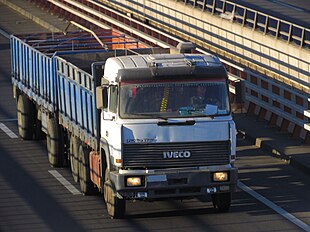Engineering:Iveco Turbostar
| Iveco TurboStar | |
|---|---|
 Iveco TurboStar 190-38 | |
| Overview | |
| Manufacturer | Iveco |
| Production | 1984-1993 |
| Body and chassis | |
| Class | Heavy-duty truck |
| Chronology | |
| Predecessor | Iveco T-series |
| Successor | Iveco EuroStar Iveco Eurotech (for Turbotech) |
The TurboStar was the name of a new truck series introduced by Iveco in 1984, for which a large-capacity cab was offered for the first time. It was based on the Iveco T series, which continued to be offered in parallel. In 1993 it was replaced by the Iveco EuroStar.
The Turbostar was very successful, especially in its home market, while it also enjoyed substantial success in other parts of Europe, with over 50,000 being sold by 1991.[1]
A less refined and cheaper variant was sold as the Turbotech.
Development
The TurboStar was developed to series production in just two years at the Ulm site. It was an evolution of the T-series, but more than 2000 components were changed compared to it. The first trials of the TurboStar began in September 1982. In the same year, a large-scale study commissioned by Iveco with more than 2000 international truck drivers had shown that one of the most important factors when choosing a new truck was cab comfort. Therefore, Iveco paid special attention to the revision of the cab and ease of use, as well as the reduction of vibrations and noise. Tests in the wind tunnel of the Fiat Orbassano research centre had led to an aerodynamically favourable cabin (Cw value 0.53). The optional roof spoilers were height-adjustable and could be adjusted to the size of the trailer. In July 1984, Iveco handed over the first 190 test vehicles of the TurboStar series to the press; In September, the Italian trade magazine tuttoTrasporti published the first photos of the new vehicle. For the first time in the truck sector, Iveco used Silver Grey Metallic as the official paint job. Previously, this was only reserved for special orders.
Place of production
The TurboStar was produced at the Turin plant as a 4x2 truck and 4x2 tractor unit. Various body manufacturers equipped the vehicles with an additional trailing axle, so that there were also 6x2 variants, but they bore the type designation of the 4x2 variant on the cab. It was not until 1986 that there were also factory 6x2 trucks and 6x2 tractor units, but only with in-line six-cylinder engines. The 240-36P 6x2 was the only variant that was also assembled in Ulm.[2]
Equipment
The exterior mirrors were electrically adjustable and heated as standard (operated via a wired remote control removable from the dashboard). The center console featured standard air conditioning and an extendable table, while the roof console featured two adjustable reading spots and three storage compartments. Roller blinds for darkening the sleeping area, air suspension, power windows in both doors were installed as standard, as well as two berths, fog lights and a wardrobe. Among the main options were refrigerator and microwave. The TurboStar was thus currently the new standard benchmark in the industry for comfort.
From model year 1990/91, a revised spoiler variant was offered as an option (primarily for tractor units). These were longer, with lateral cantilevers in the end area and were given vertical side wings running behind the cab (so-called side flaps) in order to optimize the aerodynamic closure towards the semi-trailer.
Propulsion and variants
Initially, two engines with turbochargers were available, which had already celebrated their premiere in the T-series in 1981, but were increased in performance for the TurboStar. The six-cylinder in-line engine (13,798 cc) also had intercooling and had an output of 243 kW (330 hp). The V8 cylinder (17,174 cc) had an output of 309 kW (420 hp).
As a standard transmission, Iveco used the ZF EcoSplit 16 with 16 synchronized gears. Optionally, the eight-cylinder was available with an Eaton-Fuller gearbox (13 gears), the six-cylinder with an Eaton twin splitter gearbox (12 gears). In addition, Iveco offered a semi-automatic SAMT from Eaton. An anti-lock braking system was initially optional and later installed as standard.
In 1987, the output of the 6-cylinder in-line engine was increased from 13,798 cc to 265 kW (360 hp). The engine was also used in the T-series. In 1990, its output was increased to 277 kW (377 hp). In 1989, the eight-cylinder model was fitted with intercooling and an increased output of 350 kW (476 hp). In 1990, the T-series was visually adapted to the TurboStar and named Iveco TurboTech. The large-capacity cab remained the unique selling point of the TurboStar.
From 1991 until the end of the series, the special model "Special HP" (HP for "High Performance") was offered. The "Special" stood out from the usual production vehicles with a front spoiler lip and rims painted in cab color, a reworked, longer roof spoiler with side flaps as standard, as well as a full chassis trim made of corrugated, dark gray plastic and a pair of chrome-plated compressed air fanfares arranged above the left sleeping cabin window. The special model was also characterised by a yellow decorative strip on the front and door flanks created especially for this special model, lettering "SPECIAL (HP - High Performance TurboStar)" mounted vertically on the side flaps and higher-quality cabin equipment, such as seats with turquoise blue imitation leather upholstery, colour-matched mattress cover and dark carpet. The special "Special" model was available ex works exclusively as a two-axle semitrailer tractor in the colours black metallic and white. The drive components corresponded to the engine and transmission range of the production vehicles valid at that time. Thus, the "Special" was available as Type 190-38 (designated 190–36 in Germany and Italy) and 190–48. As the pinnacle of the TurboStar evolution, the "Special" also represents, so to speak, the farewell model of this vehicle series.
References

